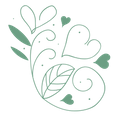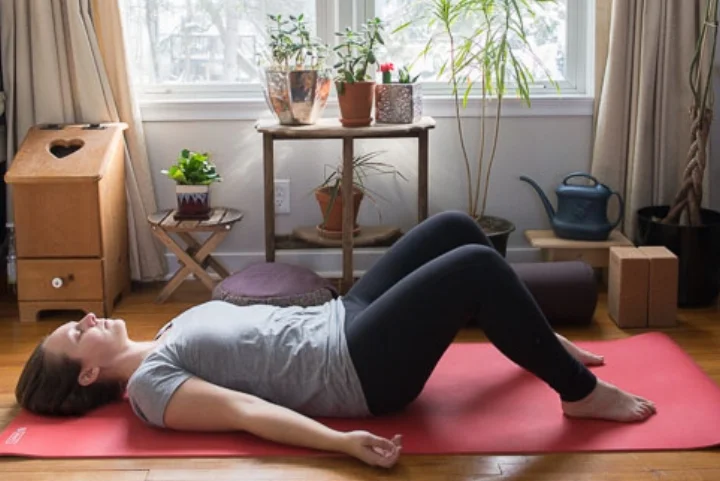Why I Practice and Teach the Tensegrity Repair Series
When I first came to yoga it was mostly for the peace and calm it brought to my mind. I was going through a difficult time in my personal life and found so much support and open-heartedness at Queen Street Yoga in Kitchener that it felt like a second home.
Constructive Rest is always Step #1 in my personal TRS practice. It is also the 'yoga pose' I recommend most frequently to anyone looking for first steps towards better self-care.
But when I made the decision to dive into my 200 hour teacher training year, I felt the need to push my practice to its physical limits. I wanted to be able to 'do more poses'. I wondered, what kind of teacher I could be if I couldn't push up to a handstand with grace and ease. As I worked towards this and other physical goals, I felt so many unexpected changes in my body. I became denser, heavier, stronger, longer, bendier, my feet grew half a size bigger (seriously!), and my muscles were tired most of the time with that good kind of soreness that follows a satisfying workout. Working hard, pushing my physical limits, and learning more about alignment and anatomy were high on my list of priorities.
I perhaps pushed myself a little too hard. Despite hearing over and over again to listen to my body and calm my mind, like so many other yoga practitioners, I struggled to let my ego soften.
And then I went paddling. A long time favoured activity with my sweetheart, we packed our bags, rented a canoe, and headed off to Killarney Provincial Park to explore some new lakes we wanted to check off our bucket list. It was October, and stormy weather was pushing through, but it was a rare and precious chance to take time away from work, and we were determined and eager to see our plans through.
A fierce headwind greeted us on George Lake, but it was as we pushed on through Killarney Lake that the pain in my left shoulder started to ring. I'm certain the fatigue in my muscles prior to the trip played a part, but it was paddling into the wind on that fateful day and steering the canoe with a few too many sweeping c-strokes that caused a handful of tiny tears to pull through the muscles of my left shoulder girdle. I saw the pain, but we were in the middle of a lake with 2 more days of paddling planned and we had driven 6 hours to get to the park. I made the decision to keep going.
Everything else about the trip was perfect, including snagging a primo site on the fabled OSA Lake that we would never have been quick enough to get a booking for during the summer season. I was glad I went, but I left the park riddled with fear over my injured shoulder.
When we returned to the city, I got an ultrasound, saw a chiropractor who performed Active Release Technique (ART) on the muscles around the affected area, I stopped going to the climbing gym altogether, and changed my yoga practice, forcing myself to stop pushing towards poses that had always been difficult and now had the potential to be increasingly injurious like chaturanga and handstands. And lucky to be in a space that nurtured self care, I took the opportunity to turn my attention to more gentle and restorative practices including the Tensegrity Repair Series (TRS).
When we are injured, sometimes stillness is required to heal. But in this case of fairly minor muscular trauma, I understood that gentle movement was better for my body in that moment. If I stayed too still, I would stiffen, layers of fascia would bind and stick, which could limit my range of motion in the longer term. And that's where my TRS practice really came in.
TRS is a series of gentle movements designed with fascia in mind. It is not an exercise of strengthening the muscles, or of stretching into new shapes, or of stacking the bones. It is a practice of lubricating the web of fascia (connective tissue) that weaves our muscles and bones together into the shape of our bodies. Through these gentle movements, we can encourage the layers of our tissues to glide across one another, loosening the adhesions of past physical traumas, or simply undoing the stiffness of repetitive motions, sitting, and poor posture patterns.
Practicing my shoulder circles - the TRS move that challenges my left shoulder most - the week before heading to French River for canoe leadership training.
Done mostly lying on your back, TRS can appear from the outside as a pretty sleepy looking workout. But this practice has so much more to offer than what might be visible from the outside. By engaging through the tips of our extremities, and moving with expansive, radiant breath, each movement offers a whole-body experience. By slowing down enough to notice the pulls, pops, and asymmetries of our movements, TRS offers a new lens through which to understand our bodies.
It took a long time after my paddling injury to be able to feel a sense of symmetry or evenness across my shoulders. I still struggle with it from time to time and wonder if the echoes of that injury will be with me for the rest of my life... one of many invisible 'scars' I bear in my body. But through TRS, along with my other mindfulness and movement practices, I have built such a strong awareness of my left shoulder, its capabilities, limitations, moodiness, and range.
I have embarked on a few low key paddling trips since that fateful day on Killarney Lake, but at least partly due to fear of re-injury, paddling has generally taken a backseat to other activities in recent years. I finally faced that fear head on this past month as I embarked on a 6-day canoe guide leadership training course with my new friend Bretton at The Land Canadian Canoe Adventures.
The course was physically demanding, and mental and nervous system fatigue also played into the challenges I faced. But throughout the week, I felt the lessons of TRS in my body in a newly enlivened way. While paddling, I worked to stabilize my pelvis and shoulders to let the sturdier muscles of my legs, core, and arms do the work. Before and after paddling, I made time for gentle movement breaks to encourage a sense of ease in my body. When I started to feel serious fatigue and a bit of pain in my left shoulder after a hard day of whitewater skills training, I had the self-awareness and confident understanding of my body to take things down a notch and ask for help. When my trip companions struggled with discomfort from hours of kneeling in their boats and strains to their back and shoulder muscles, I felt empowered to offer them restorative movement ideas stemming from yoga and my TRS practice.
Nothing in life is a cure-all. But in this world of fast-paced progress, where so many of us struggle to balance our minds and bodies through huge physical and mental demands, I believe there is certainly a place to be made for more gentleness.
I have been incorporating movements from TRS into my regular yoga classes for several years and completed a TRS teacher training program with Trudy Austin in 2017. This weekend I'll be teaching a workshop that introduces the basic TRS movements and the rationale behind them. Come check it out at Peterborough Living Yoga from 1:00-3:30pm on Sunday, June 3rd.

